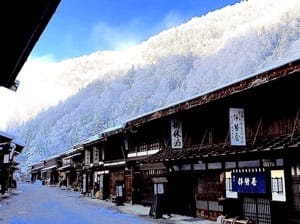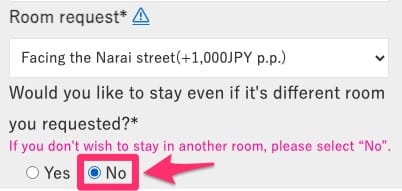How to enjoy the Narai Juku【Nakasendo Trail】
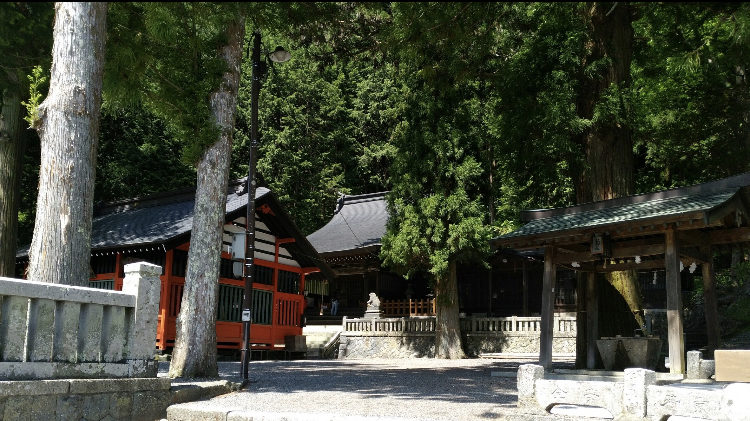
This page introduces a model course summarizing the attractions of Narai-juku.
- What should you see in Narai-juku?
- You understand it’s an old town, but want to know more.
- You want to know the must-visit places.
We hope this is helpful for those like you.
Model Course Overview
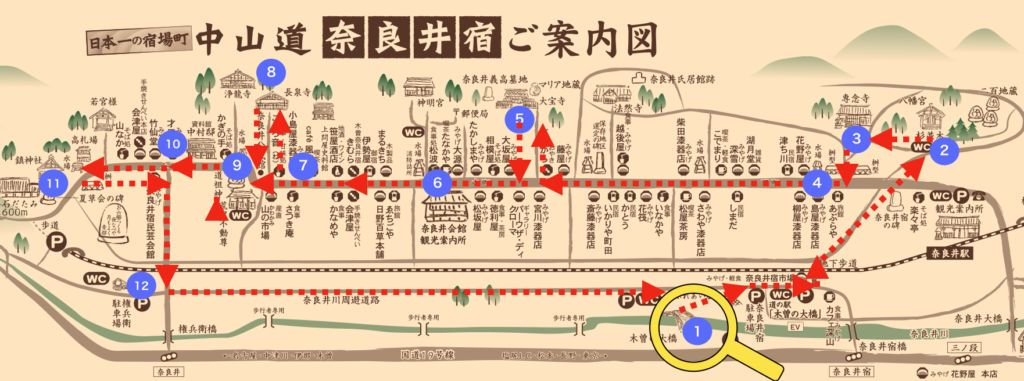
Narai-juku mascot character: “Nararachan”
 なららちゃん
なららちゃんStarting and finishing at Kiso Ohashi Bridge, this course takes you around Narai-juku.
Photography is recommended during early mornings or evenings with fewer people.
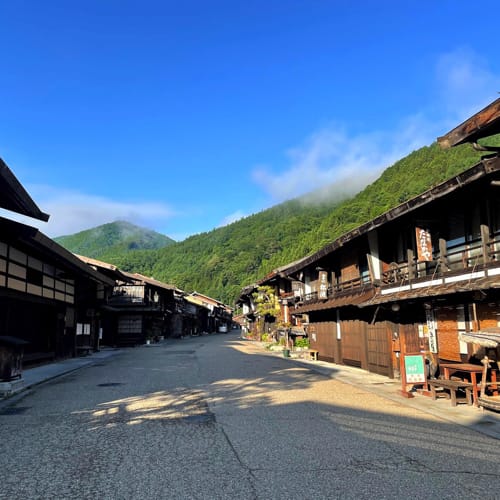

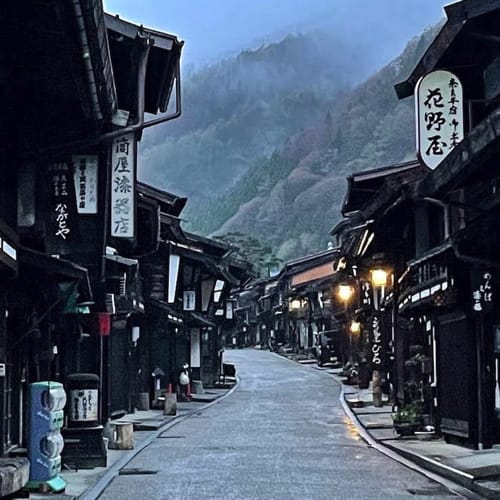

Enjoy it along with the experience of staying in the town.
①Kiso Ohashi Bridge
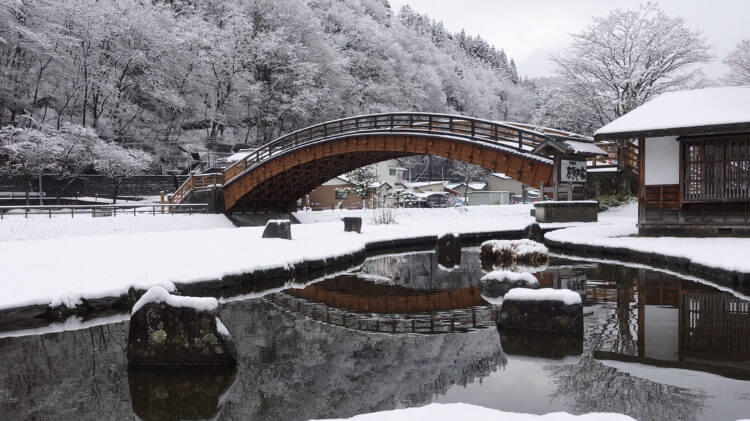

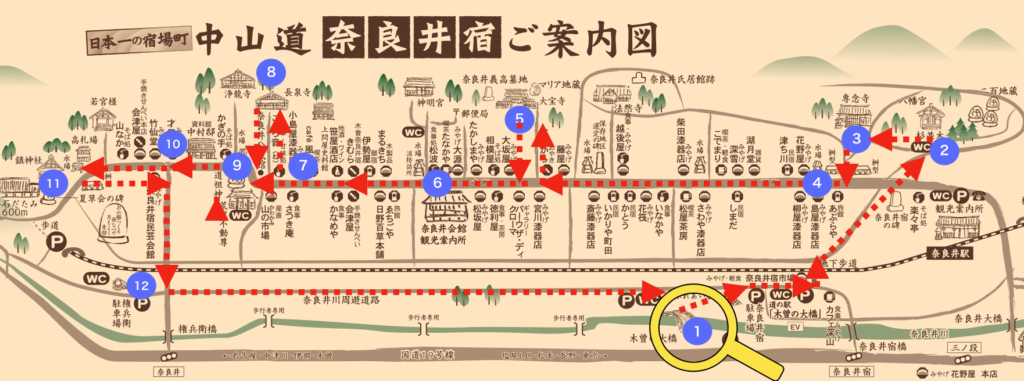

The starting point is Kiso Ohashi Bridge.
If you’re coming by car, using Kiso Ohashi East Parking (free) is convenient. >>‘Access to Kiso Ohashi East Parking (National Route Side) [Free]’
Kiso Ohashi, made using only Kiso Hinoki, a specialty of the Kiso region, is one of Japan’s largest wooden bridges without bridge piers.
From the park’s pond, you can capture the reflection of Kiso Ohashi Bridge on the water’s surface.





It’s also illuminated from sunset to 9 p.m.!
Flowing under the bridge is the Narai River, one of the sources of the longest Shinano River in Japan.
From the opposite side of crossing Narai River, you have a backdrop of mountains.


You can enjoy fantastic scenery in every season, be it spring, summer, autumn, or winter.
Kiso Ohashi Bridge: Basic Information
| Address | 1343-49 Narai, Shiojiri, Nagano 399-6303 |
|---|---|
| Fee | Free |
| Operating Hours | 24 hours (Illumination: Sunset to 21:00) |
| Recommended Season | Year-round |
| Parking | Available (Details here) |
| Contact | Narai-juku Tourist Association |
②Nihyaku Jizo, Suginamiki, Hachimangu Shrine
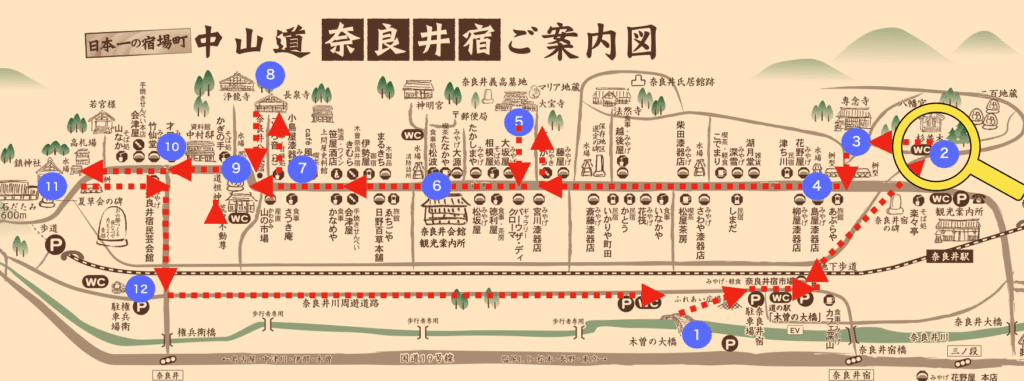




Here, three spots are clustered together, so let’s introduce them all at once!
Suginamiki (Cedar Tree-lined Path)
The old Nakasendo Road. In the past, it connected Narai-juku to Kiso Hirasawa in the north via this narrow road.
The cedar tree-lined path, said to be several hundred years old, has witnessed the footsteps of many people from the distant past.
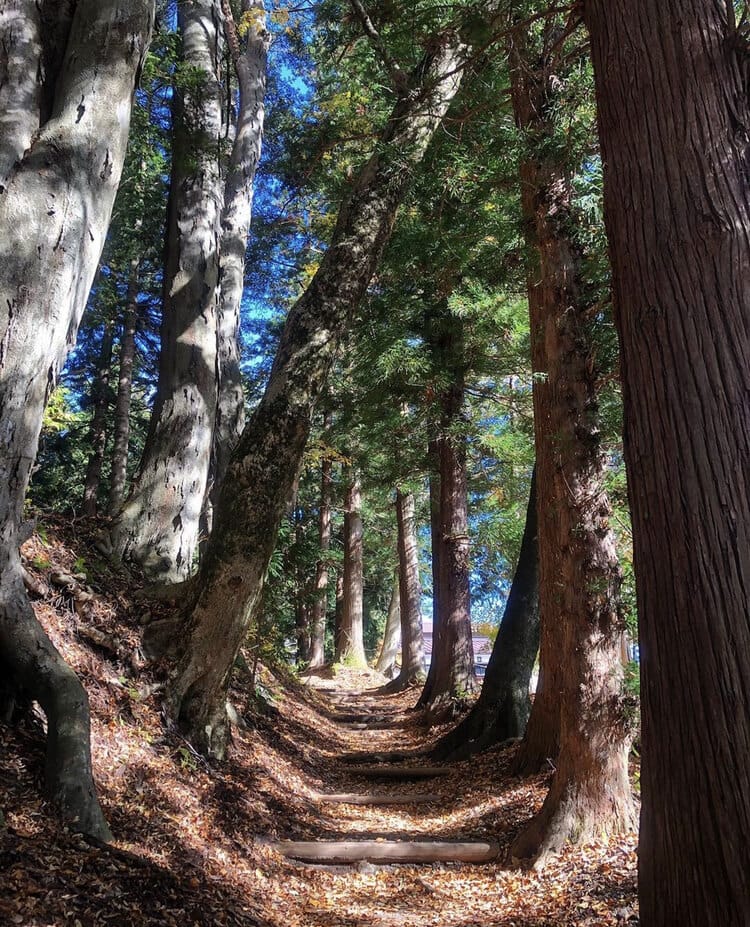

Winter in the cedar tree-lined path. Snow lightly accumulates while being sheltered by the lush trees.
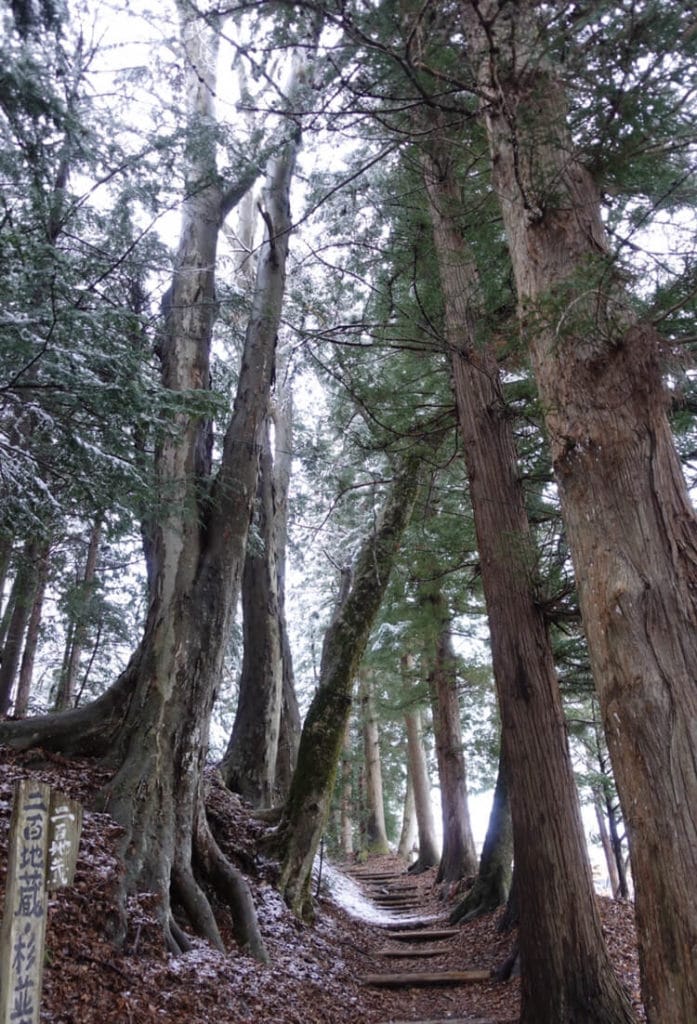

Nihyaku Jizo (Two Hundred Jizo Statues)
After passing through the cedar tree-lined path, you’ll find a serene collection of stone Jizo statues.
These Jizo statues were gathered and enshrined here, having lost their place during the Meiji era’s national road and railway development in various parts of Narai-juku.
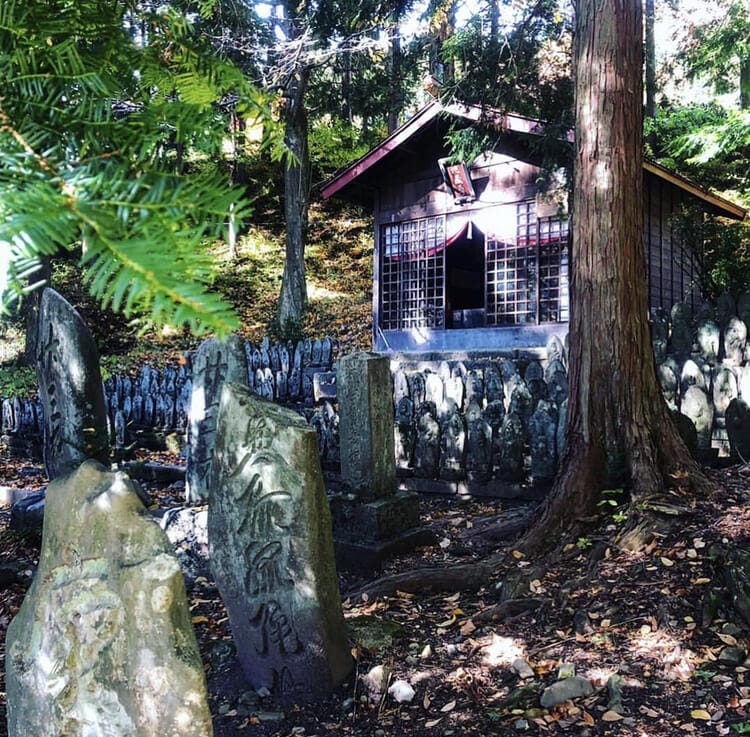

Winter at Nihyaku Jizo. Its striking appearance is enhanced by the white snow and the blue of moss.
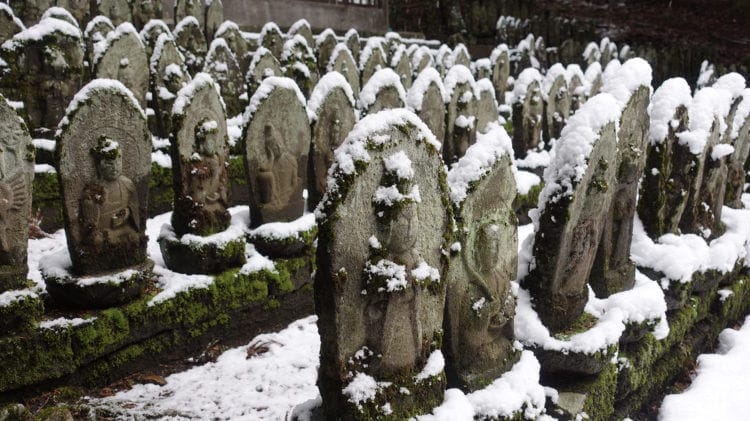

Hachimangu Shrine
Hachimangu Shrine has been revered as the guardian deity of Narai-juku’s downtown area for a long time.
This shrine, quietly standing beside the bustling Narai-juku, can make you forget the busy modern world.
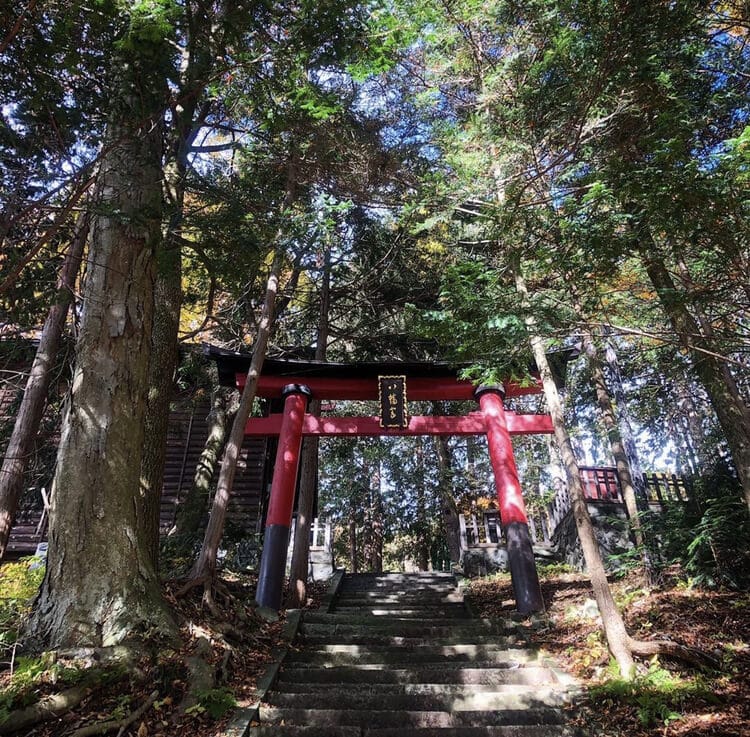

Winter at Hachimangu Shrine.
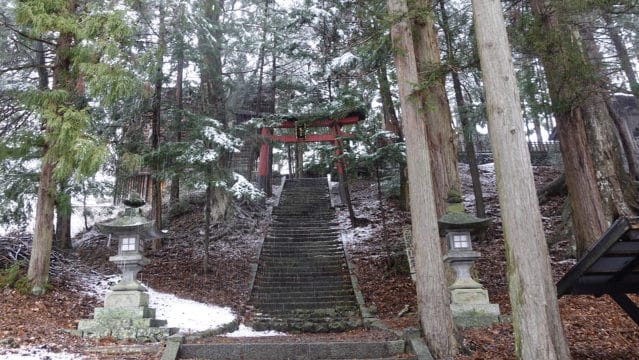

Nihyaku Jizo, Suginamiki, Hachimangu Shrine: Basic Information
| Address | 960-1 Narai, Shiojiri, Nagano 399-6303 |
|---|---|
| Fee | Free |
| Operating Hours | 24 hours |
| Recommended Season | Year-round |
| Parking | Not available (Please use nearby parking) |
| Contact | Shiojiri City (0263-52-0280) |
③ Sennen-ji Temple
Among the five temples remaining in Narai-juku, this is the northernmost Jodo Shinshu temple.
The large ginkgo tree behind the temple bell turns bright yellow in autumn.
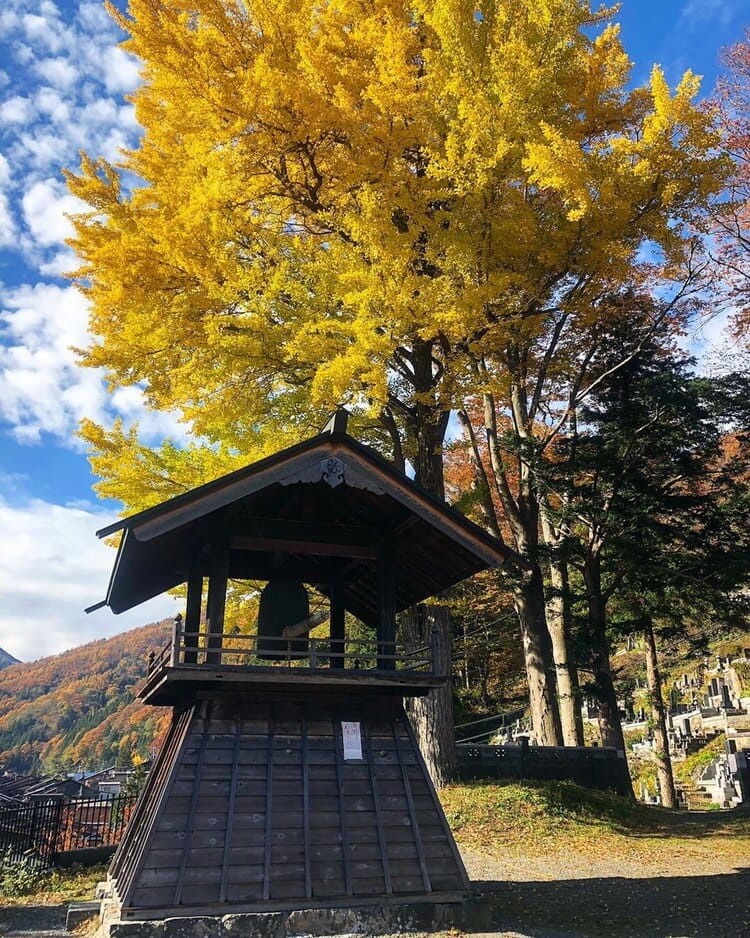

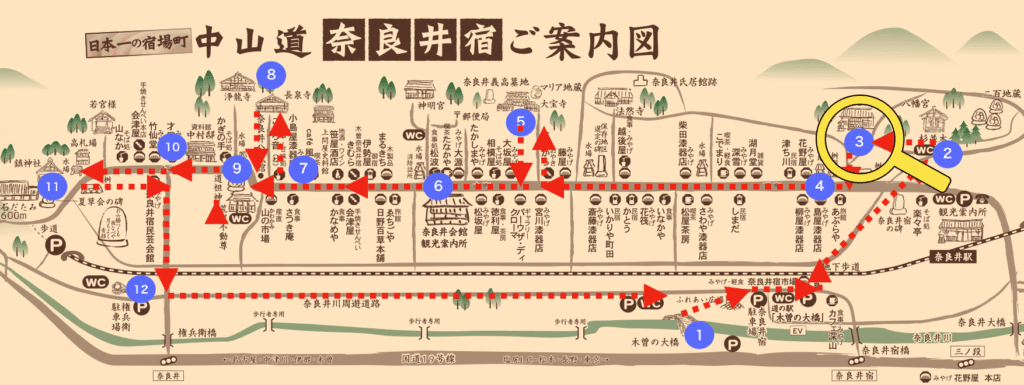

Founded in 1532, the current main hall was rebuilt in 1729 after a fire in 1727.
It’s also beautiful when covered in winter snow.
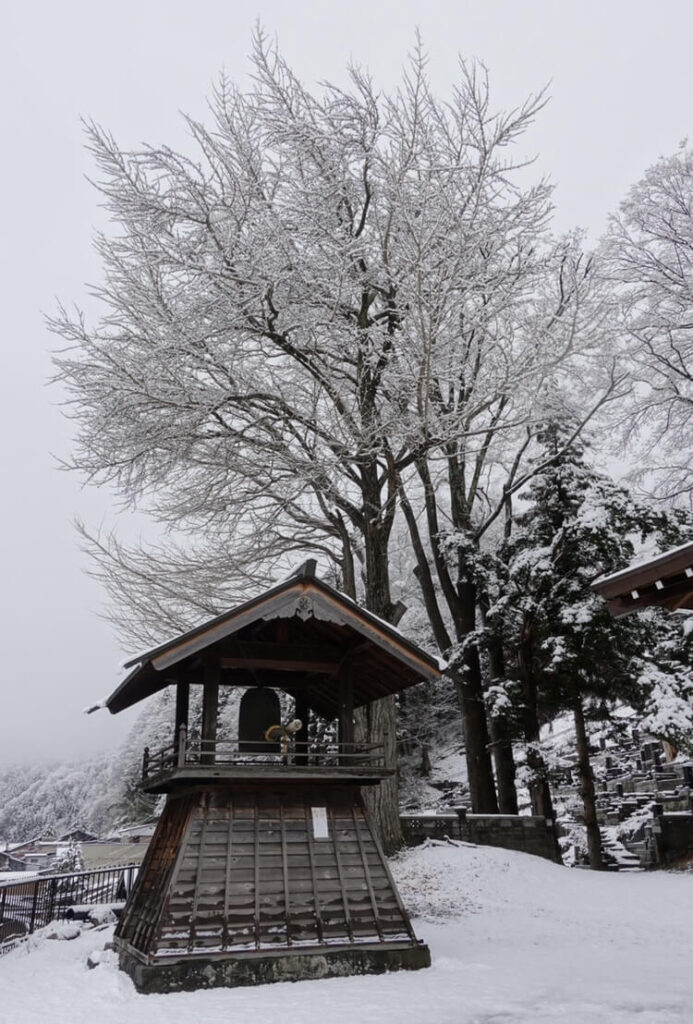

In front of the temple, there are two massive rocks called “Unari-ishi”.


There is a legend that says the rocks used to make loud noises, but they were silenced by driving nails into them.



It’s said that those nails are still there! Try to find them.
Sennen-ji Temple: Basic Information
| Address | 751 Narai, Shiojiri, Nagano 399-6303 |
|---|---|
| Fee | Free |
| Recommended Seasons | Autumn, Winter |
| Parking | Not available (Please use nearby parking) |
| Contact | 0264-34-3007 |
④ Narai-juku Shitamachi (Lower Town)
This is the most famous viewpoint in Narai-juku. Many posters and promotional photos of Narai feature shots taken in the lower town.
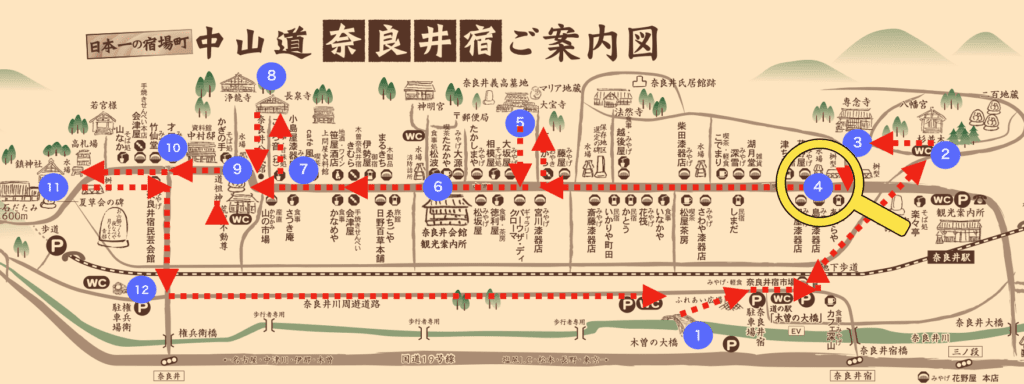

Narai-juku features a unique architectural style called “Deurabezukuri,” where the second floor extends outward. The main street, intentionally winding to obstruct the view, is lined with houses that appear to overlap each other on both sides.



It’s interesting to note that the lower town used to be a town of lacquer craftsmen specializing in bentwood products!
During the summer festival on August 11-12 each year, lanterns line the streets. Each house uses lattice and bamboo blinds, creating a delightful and cooling landscape.
Snow-covered lower town. Many visitors come here to capture shots in this snowy setting.
Night in the lower town.
During the annual Ice Candle Festival on February 3rd and the Lantern Festival in late February, the streets on both sides are illuminated by warm lights (the photo below shows the Lantern Festival).
⑤大宝寺
Located in the middle of Narai-juku, Daibo-ji Temple is known for its impressive entrance gate and the combination of trees that change color with the seasons, which inspire a desire for photography.
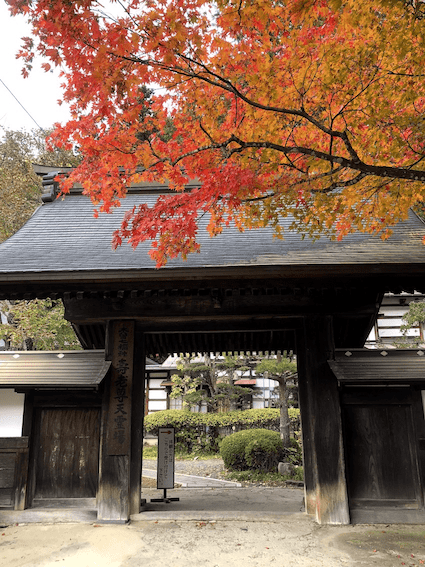



Rinzai Zen Myoshinji Sect, Hirodenzan
Established approximately 400 years ago in the 10th year of the Tensho era. It is known as a temple along the Shinshu Kiso Pilgrimage, the Seven Lucky Gods pilgrimage, and is also famous as a temple of Jurojin, the god of wisdom and longevity.
Inside the temple grounds, there is a Maria Jizo statue, which survived the Christian prohibition era in the Edo period, with only its cross remaining.
The back garden was created during the Kyoho era and features beautiful azaleas that bloom around June and stunning autumn foliage.
Quoted from: Narai-juku Tourist Association Website
The temple office is unmanned, and instructions are written on the desk. I wonder if this black telephone is still connected and functional...
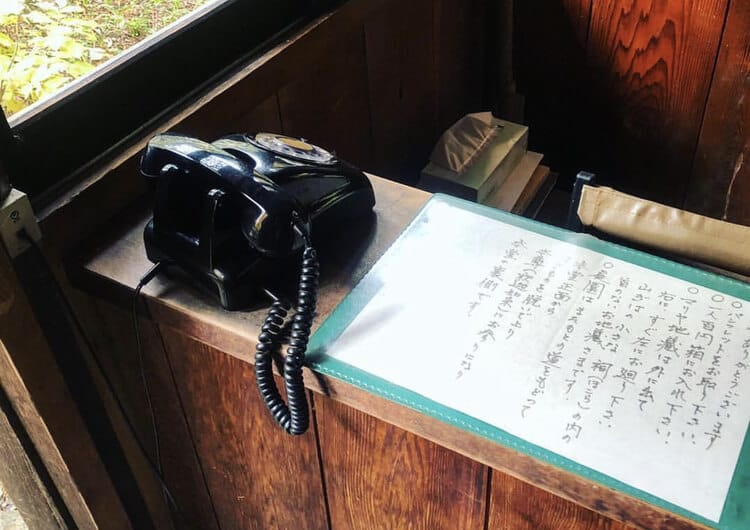

The garden behind the main hall is particularly beautiful during the autumn foliage season. It's a hidden gem where tourists rarely visit, so you can enjoy a peaceful moment here.
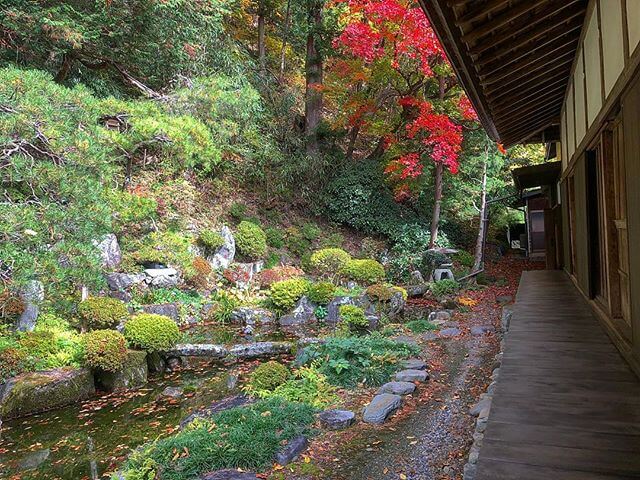




There is also a Jizo statue without a head, which was enshrined due to the ban on Christianity...
Daibo-ji Temple: Basic Information
| Address | 423 Daibo-ji, Narai, Shiojiri, Nagano 399-6303 |
|---|---|
| Admission Fee | 100 yen |
| Opening Hours | Open from morning to evening |
| Recommended Seasons | June (Azaleas), Mid-October to Mid-November (Autumn Foliage) |
| Parking | Not available (Please use nearby parking lots) |
| Contact | 0264-34-3147 |
From this point onward, you'll find more dining options and places for food exploration.
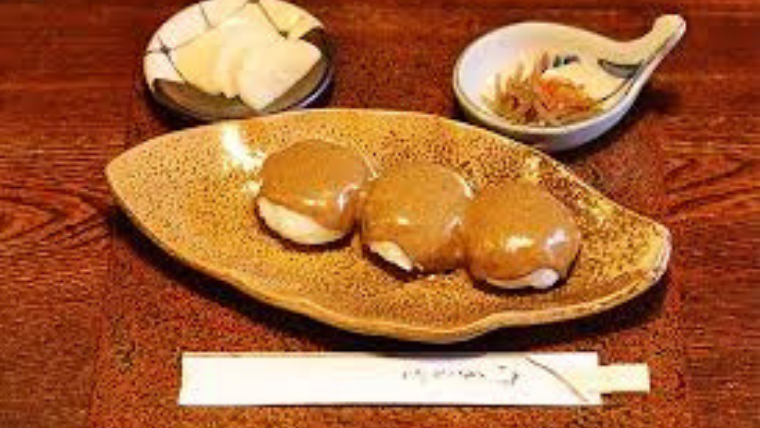



⑥中町
Once you pass the "Yokomizu" water source just before Daibo-ji Temple, you'll enter Narai-juku's central town. You'll notice that the road widens as you enter this central town area.
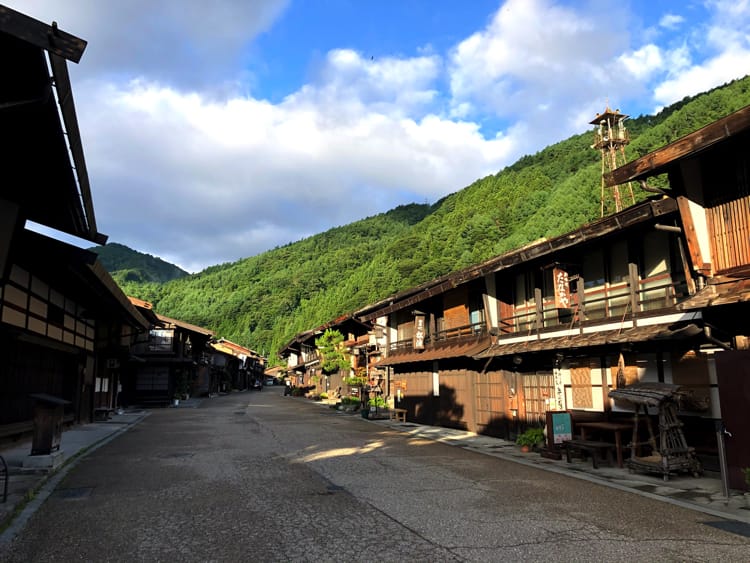

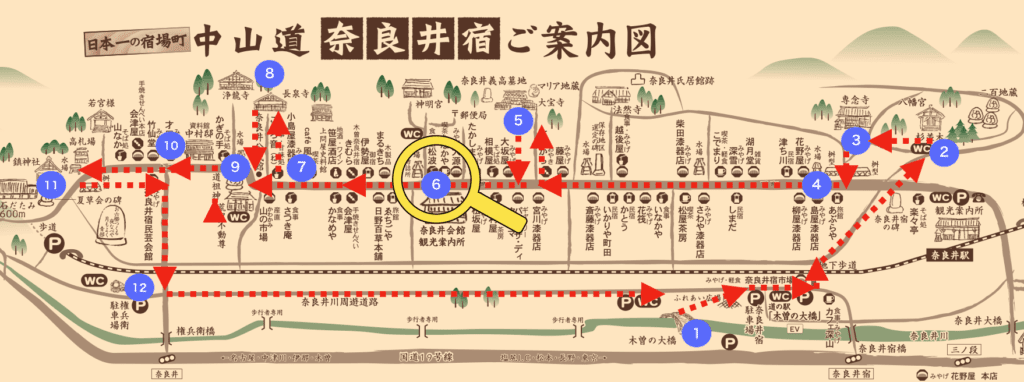

In the central town, you'll find the "Honjin" and "Waki-Honjin," accommodations where important figures such as imperial family members and shogunate officials stayed.
As this area played a central role in Narai-juku, the streets are wider, and larger houses line the road.
In the Edo period, the amount of land tax was determined by the width of the house. Therefore, most houses have narrow facades and elongated structures known as "unagi-no-nedoko" (eel beds) at the back.
However, prestigious houses like the Honjin and Waki-Honjin have about twice the width of other houses. Be sure to spot them!
The former Waki-Honjin, now known as "Oyado Iseya," has been converted into a guesthouse and welcomes many visitors.
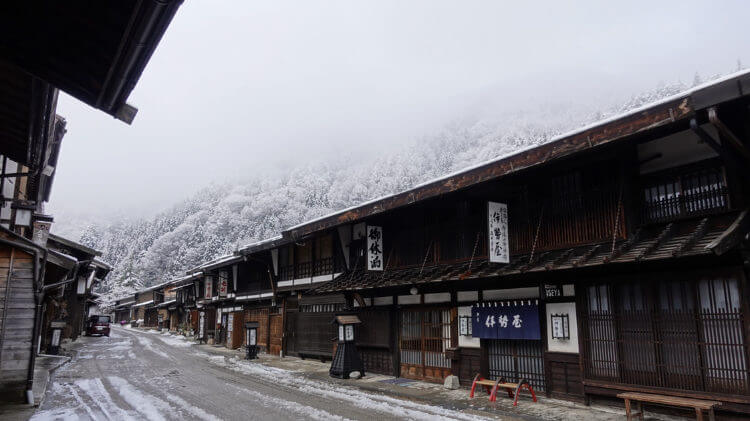

A summer day in Central Town.
⑦ Kamidonya Museum
The former Tezuka family residence, which served as both a Kamidonya (upper warehouse) and a village headman's house during the Edo period, has been preserved and turned into a museum.
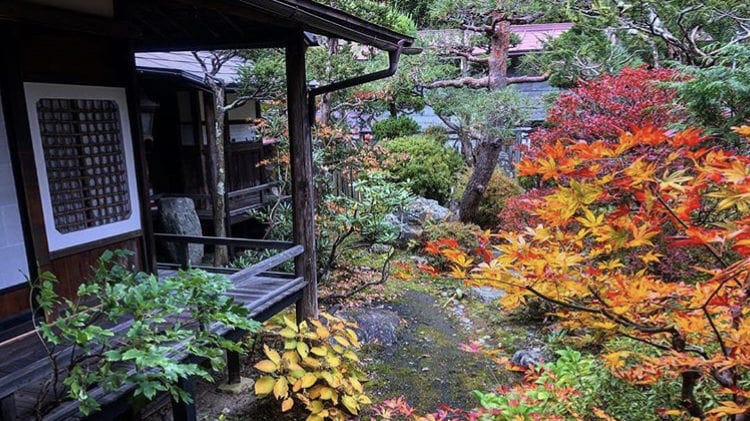

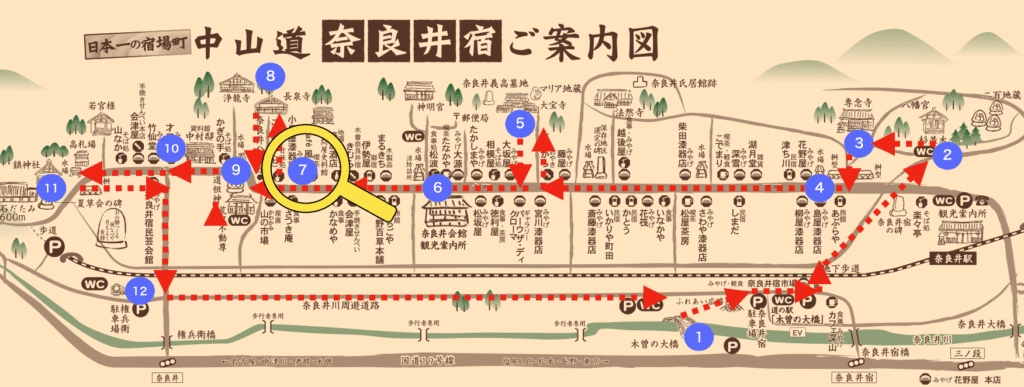




The building is designated as an important cultural property by the country!
In autumn, the garden boasts stunning foliage, while in summer, it is adorned with the natural greenery.
The wooden floors, meticulously maintained over the years, gleam black and reflect the light pouring in from outside.
Inside, there are various items such as ancient documents, pottery, lacquerware, and more, totaling up to 400 pieces. These are collections accumulated over a long period of 270 years, dating back to the Edo period.


Staircase chest: You can see the wisdom of the indigenous people in using the staircase area for storage. You can still climb these stairs today!
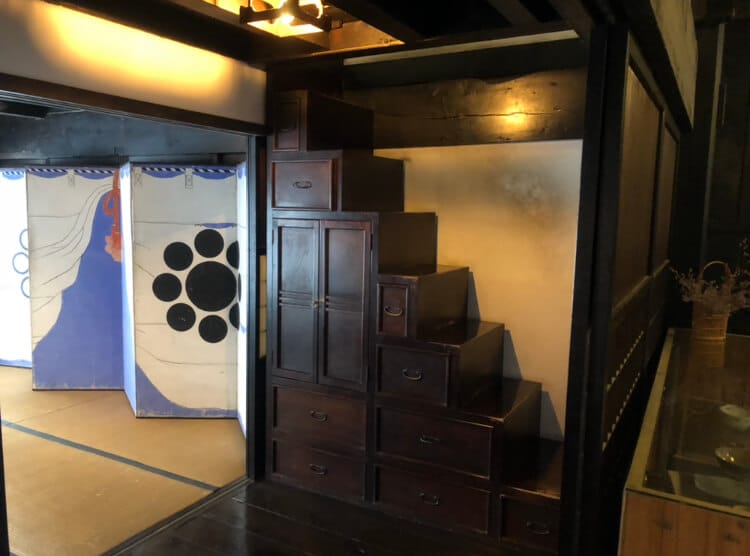

It opens up nicely, although there's nothing inside.
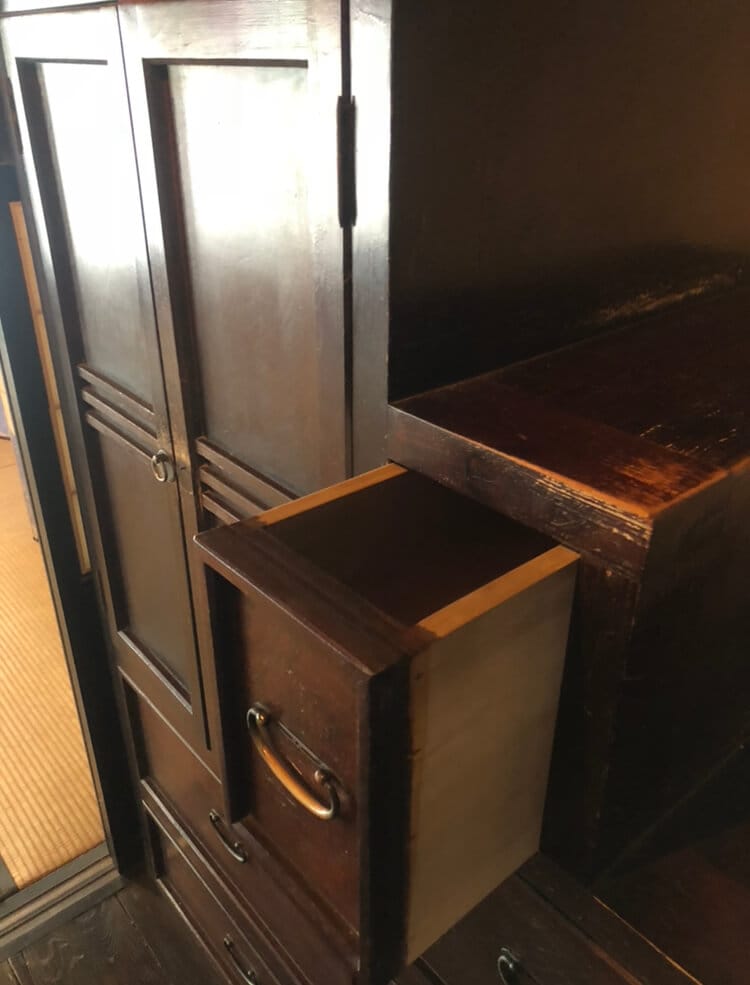

Take a photo from the second floor after climbing the stairs. Be careful not to bump your head on the ceiling when climbing!
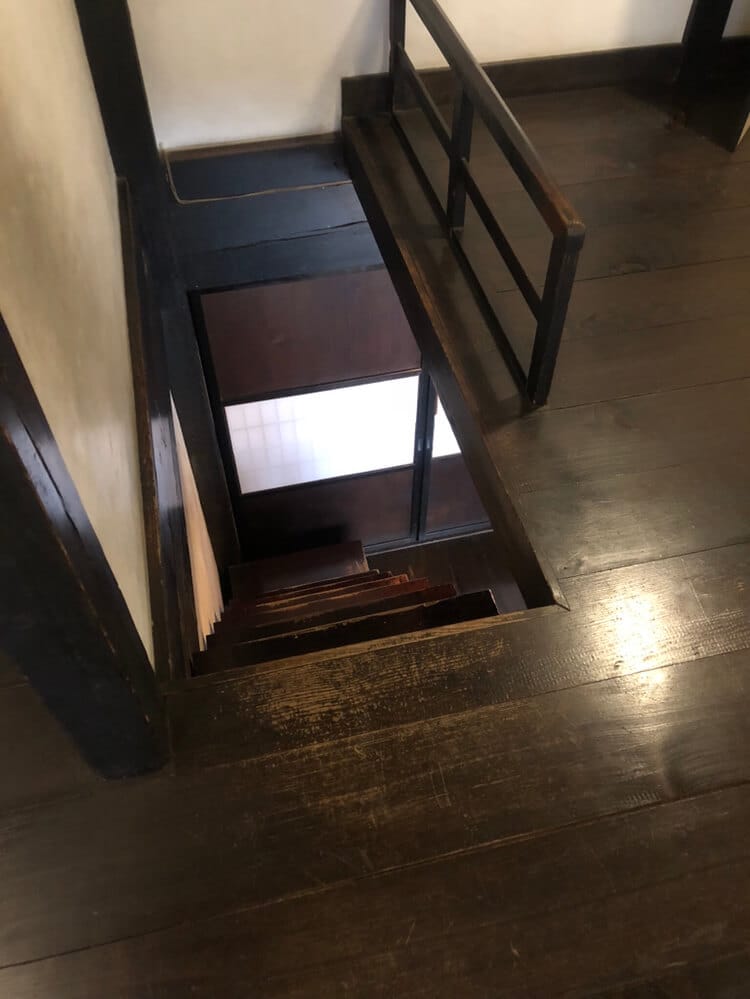




The room where Emperor Meiji had lunch is also preserved.
Uemotoya Archive Museum: Basic Information
| Address | 379 Narai, Shiojiri City, Nagano Prefecture 399-6303, Japan |
|---|---|
| Admission Fee | ¥300 |
| Opening Hours | Open from April to October: 10:00 AM - 5:00 PM / Closed at 4:00 PM in March and November / Closed from December to February with irregular closures on other months |
| Recommended Seasons | Spring to Autumn |
| Parking | Not available (please use nearby parking lots) |
| Contact | 0264-34-3101 |
⑧ Chosenji Temple
Chosenji Temple is a Soto Zen temple located at the southern end of Naraijuku Nakamachi. It was originally constructed in 1366 as a temple of a different sect but underwent multiple reconstructions and conversions. The current main hall is said to have been rebuilt in 1866.
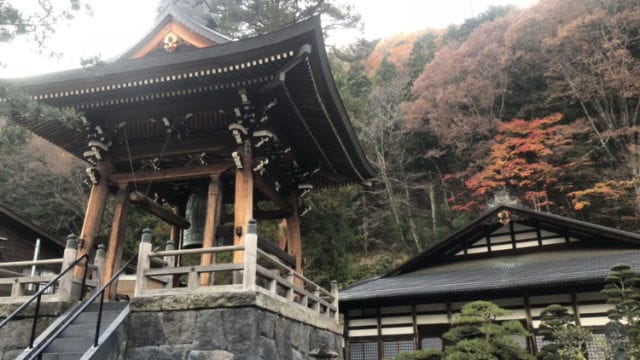

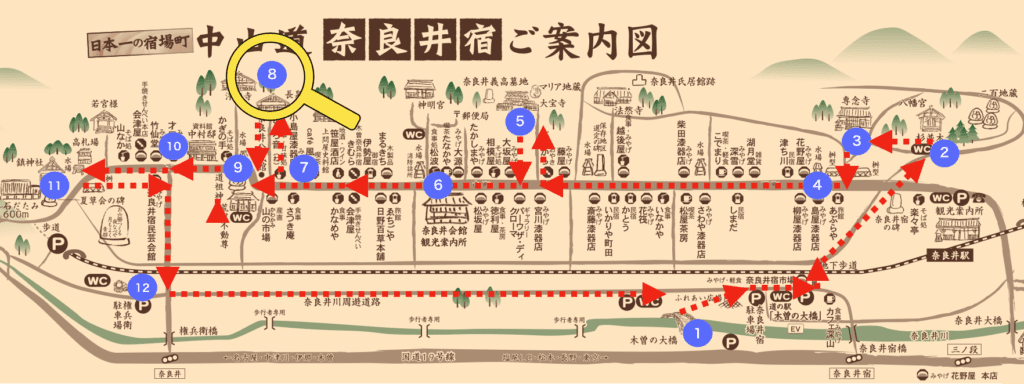

You can enjoy a beautiful view of the stars when you visit at night.
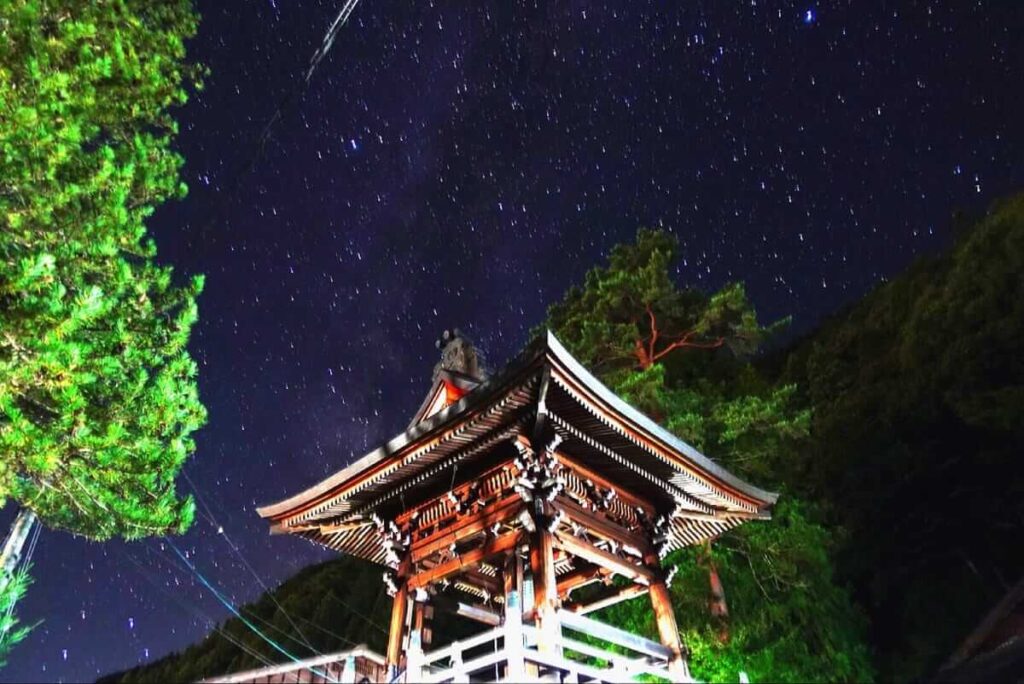




The highlight of Chosenji Temple is the "Dragon Ceiling Painting" at the entrance of the main hall, which you can enjoy for free.
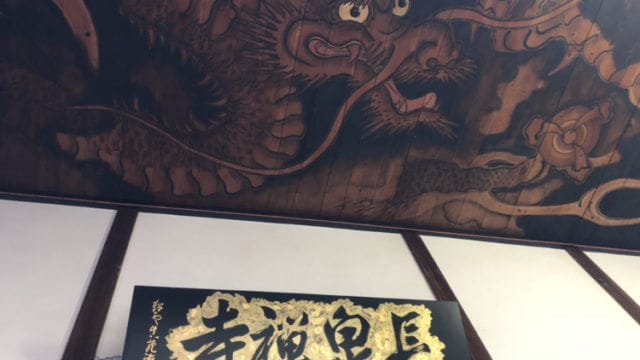

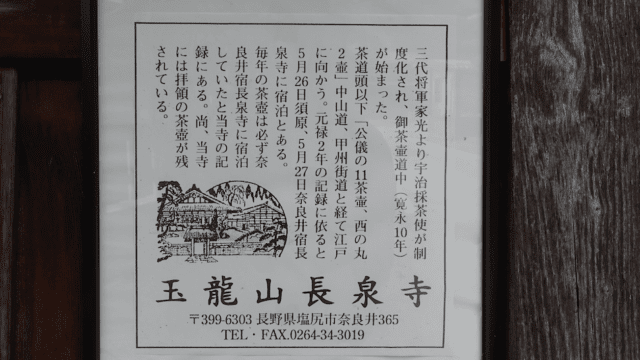

Furthermore, Chosenji Temple was the main lodging place for the "Tea Urn Procession" that transported Uji tea to Edo during the era of Tokugawa Iemitsu. Even today, remnants of the tea urns from that time are preserved here.
Every year during the Naraijukuba Festival in June, a reenactment of the Tea Urn Procession takes place starting from Chosenji Temple.
Additionally, if you're lucky, you might be greeted by Ragdoll cat "Ragu-chan," the temple's resident cat!
Chosenji Temple: Basic Information
| Address | 365 Naraai, Shiojiri City, Nagano Prefecture 399-6303, Japan |
|---|---|
| Admission Fee | Free |
| Opening Hours | Open during temple hours: Morning to evening |
| Recommended Seasons | Year-round |
| Parking | Not available (please use nearby parking lots) |
| Contact | 0264-34-3019 |
⑨ Narai juku Kanmachi (Upper Town)
Kamimachi became famous as a filming location for the NHK TV drama series "Ohisama" aired in 2011, and it played a significant role in introducing Naraijuku to the entire nation.
Many residents of Naraijuku also appeared as extras in the series.
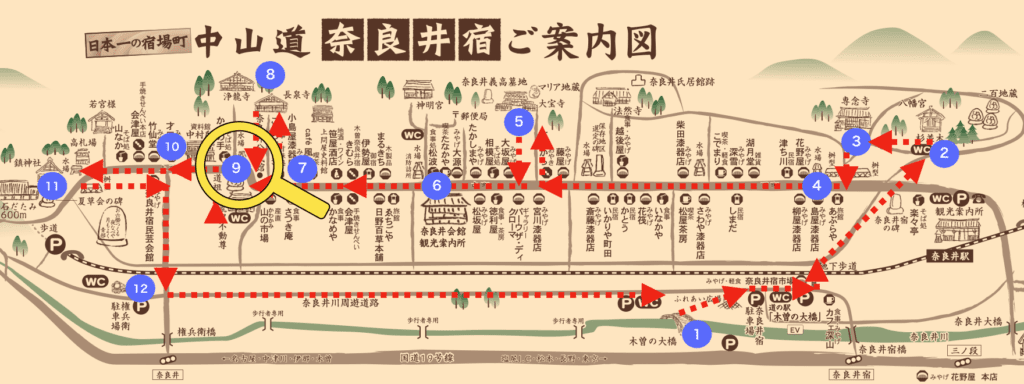

Here is an actual scene from "Ohisama." Can you recognize it as Naraijuku Kamimachi?
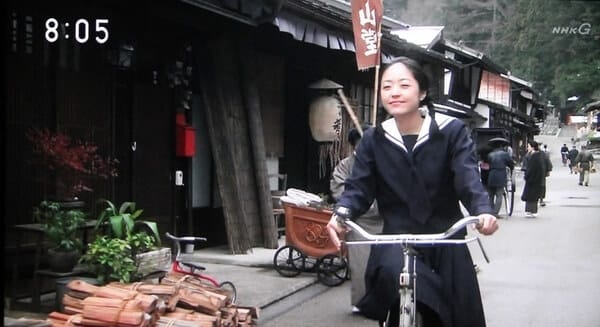

In addition, Kamimachi was also used as a filming location for the 2018 Christmas special drama "Inugami Family." Kamimachi seems to be a popular location for filming. Quite enviable!



Kamimachi prospered as a town of craftsmen specializing in Orokushi production during the Edo period.
⑩ Nakamura Residence
The Nakamura Residence, which thrived as a wholesale distributor of Orokushi, a specialty product of Naraijuku and the neighboring Yabuharajuku.
It was built around 1830 and features typical architectural styles of Naraijuku, including Deiryouzukuri, Shutter Doors, Armored Eaves, Saruzaki, and is an important building that played a key role in preserving the townscape of Naraijuku.
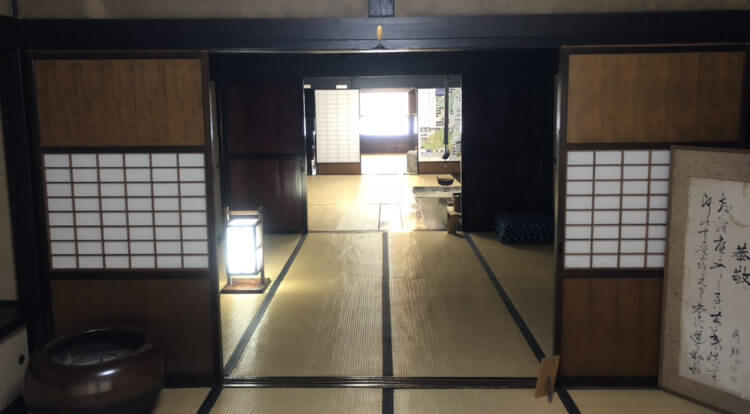

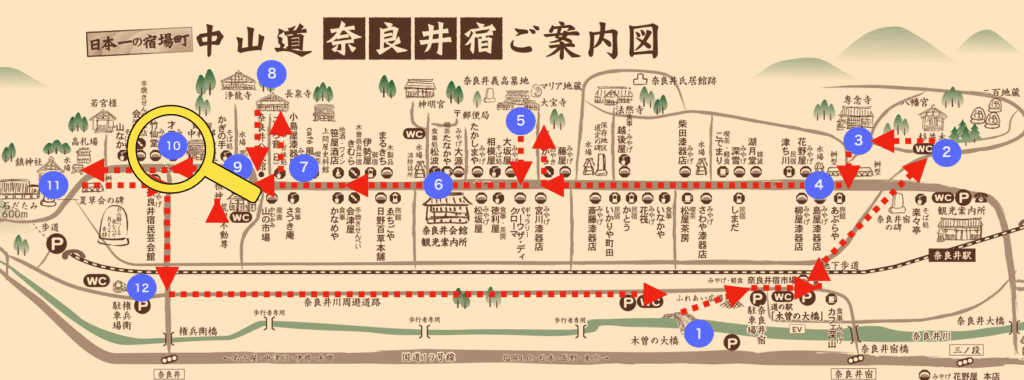

[chat face="nararachan211-1.gif" name="Nararachan" align="right" border="none" bg="gray" style=""]It's designated as a tangible cultural property of Shiojiri City! It's an important building that contributed to the preservation of Naraijuku's townscape![/chat]
It has an impressive open ceiling and an irori (sunken hearth).
この投稿をInstagramで見る
Various household items that were once used are also on display.
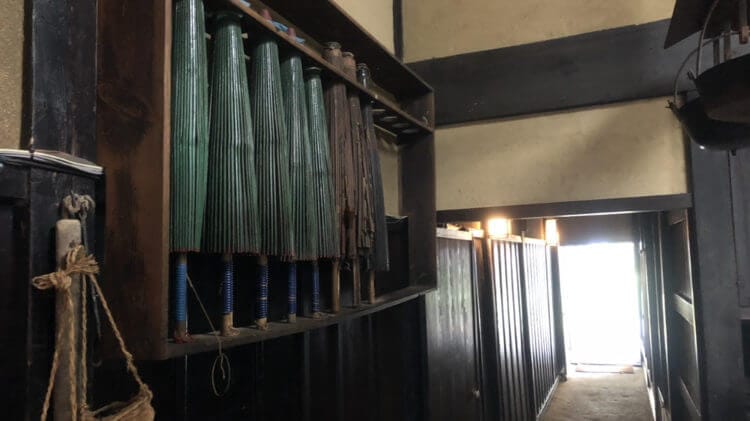

Nakamura Residence: Basic Information
| Address | 〒399-6303 Nagano Prefecture, Shiojiri City, Naraijuku 311 |
|---|---|
| Admission Fee | ¥300 |
| Opening Hours | April to November: 9:00 AM to 5:00 PM / December to March: 9:00 AM to 4:00 PM Closed on Mondays |
| Recommended Season | Year-round |
| Parking | Not available (Please use nearby parking facilities) |
| Contact | 0264-34-2655 |
⑪ Shizume Shrine
Shizume Shrine is the last thing you'll see in the townscape of Naraijuku.
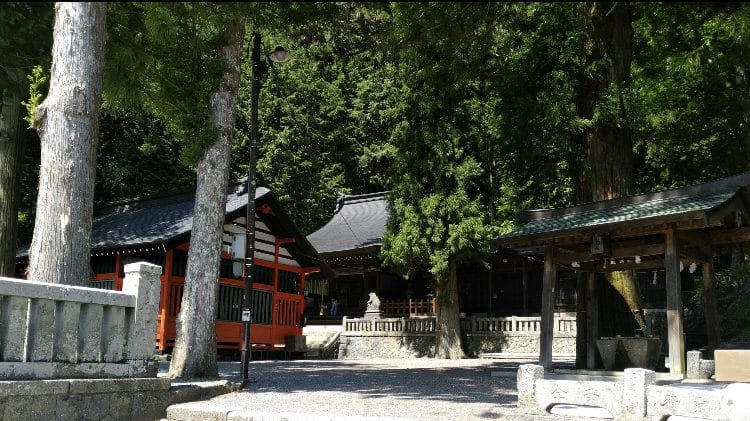



During Naraijuku's summer festival held on August 11th and 12th every year, the main hall's doors are opened, and you can visit the hall.
↓ I made a video of Shizume Shrine ↓
Overlooking Naraijuku from the shrine's precincts.


This is the front view of the shrine.
Signs prohibiting the entry of cars and horses can be seen.
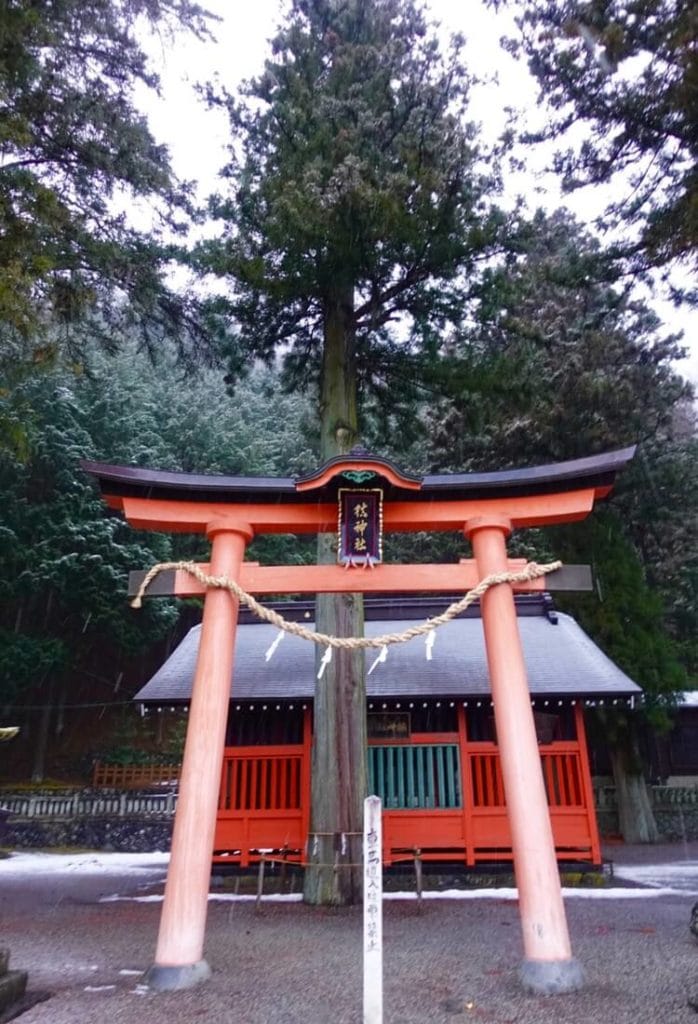

Shizume Shrine at night.
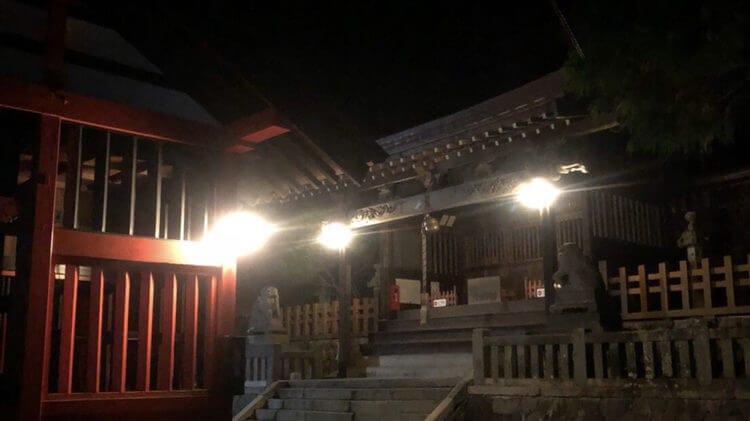

There are also guardian dogs (komainu).
Shizume Shrine: Basic Information
| Address | 〒399-6303 Nagano Prefecture, Shiojiri City, Naraijuku |
|---|---|
| Admission Fee | Free |
| Opening Hours | Open 24 hours |
| Recommended Season | Spring to Autumn |
| Parking | Not available (Please use nearby parking facilities) |
| Contact | 0264-34-3160 |
⑫ Steam Locomotive
Finally, we have Naraijuku's steam locomotive.
To reach it, follow the road east from Shizume Shrine and cross the railroad crossing. You'll see the steam locomotive at the back of Naraizugonbei Parking Lot.
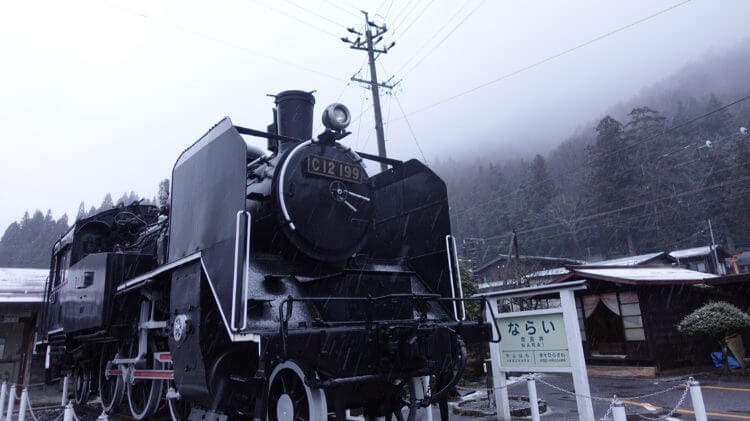

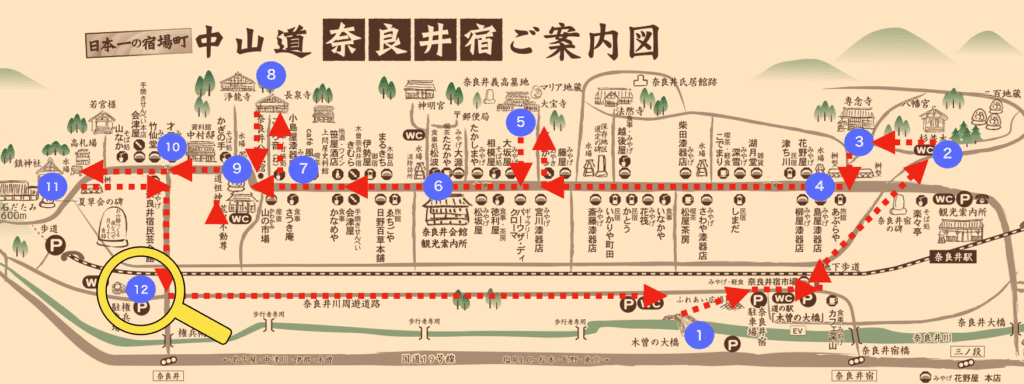

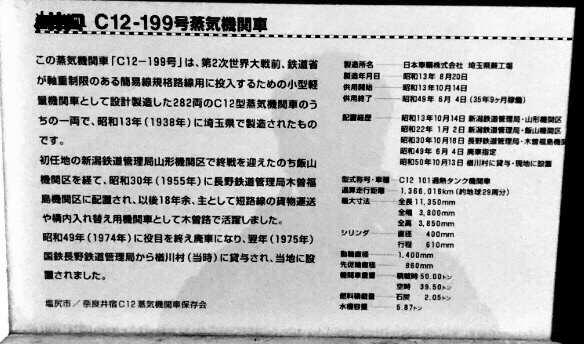

It's not a D51, but it's called "Degoiichi" by the locals... It's actually a C12 type.
This small steam locomotive, C12-199, was manufactured in 1938. Originally, it operated in Niigata Prefecture and later in the northern part of Nagano Prefecture, serving in the transportation of goods along the Nakasendo trail.
After retiring in 1974, it was loaned from the Japanese National Railways (JNR) the following year and has been displayed here ever since.
They even installed a fence around it now.
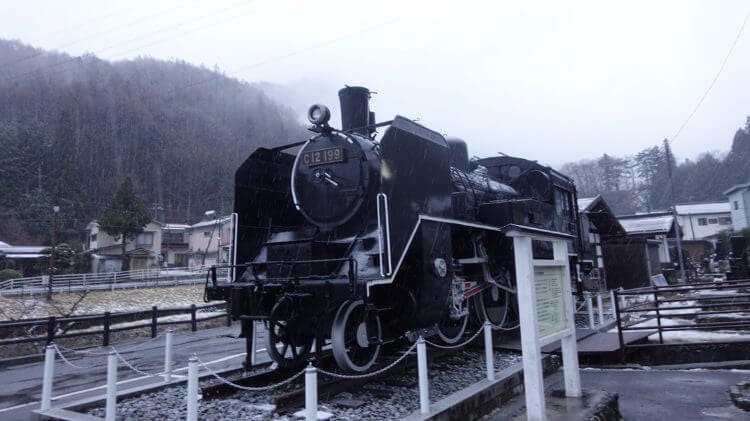

Steam Locomotive: Basic Information
| Address | 〒399-6303 Nagano Prefecture, Shiojiri City, Naraijuku |
|---|---|
| Admission Fee | Free |
| Opening Hours | Open 24 hours |
| Recommended Season | Year-round |
| Parking | Paid parking available: ¥500 (Details and nearby free parking here) |
| Contact | 0264-34-3160 Naraijuku Tourist Information Office |
Finally: Return to Kiso no Ohashi and Enjoy the Source of the Shinano River
As you return from the steam locomotive to the starting point, Kiso no Ohashi, take a moment to look at the Naraigawa River flowing right beside it.
This Naraigawa River is the source of Naraijuku, and eventually merges into Japan's longest river, the Shinano River, which flows into the Sea of Japan.
Furthermore, if you look to the south, you'll see the towering Torii Pass.
Torii Pass serves as a watershed, and beyond the pass, the Kiso River flows from Kizomura into the Pacific Ocean.
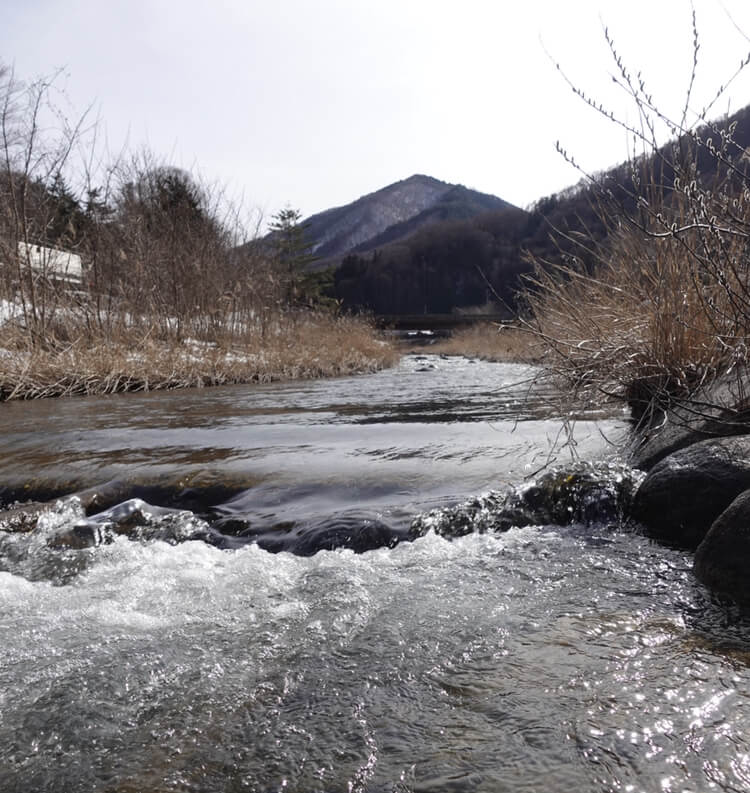

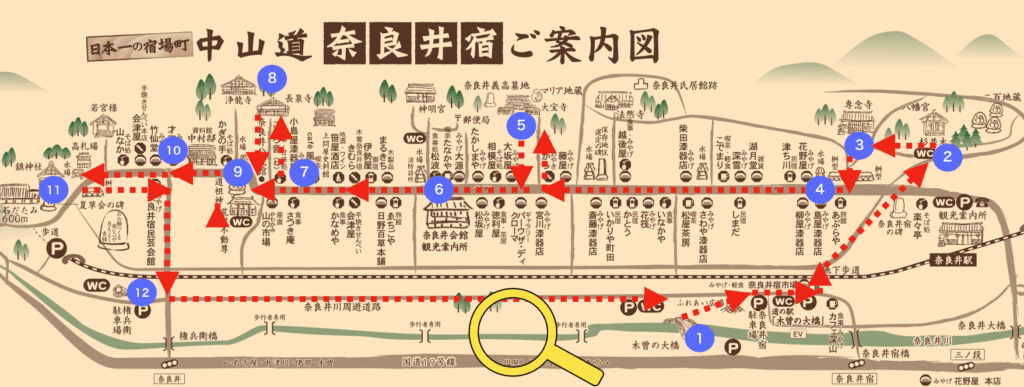

It divides into a river flowing to the Pacific Ocean and a river flowing to the Sea of Japan, separated by Torii Pass.
This Torii Pass, which was once considered the most challenging part of the Kiso Road, has become popular in recent years as a trekking course that is easily accessible.
That concludes the guided tour! Enjoy your exploration of Naraijuku✨
